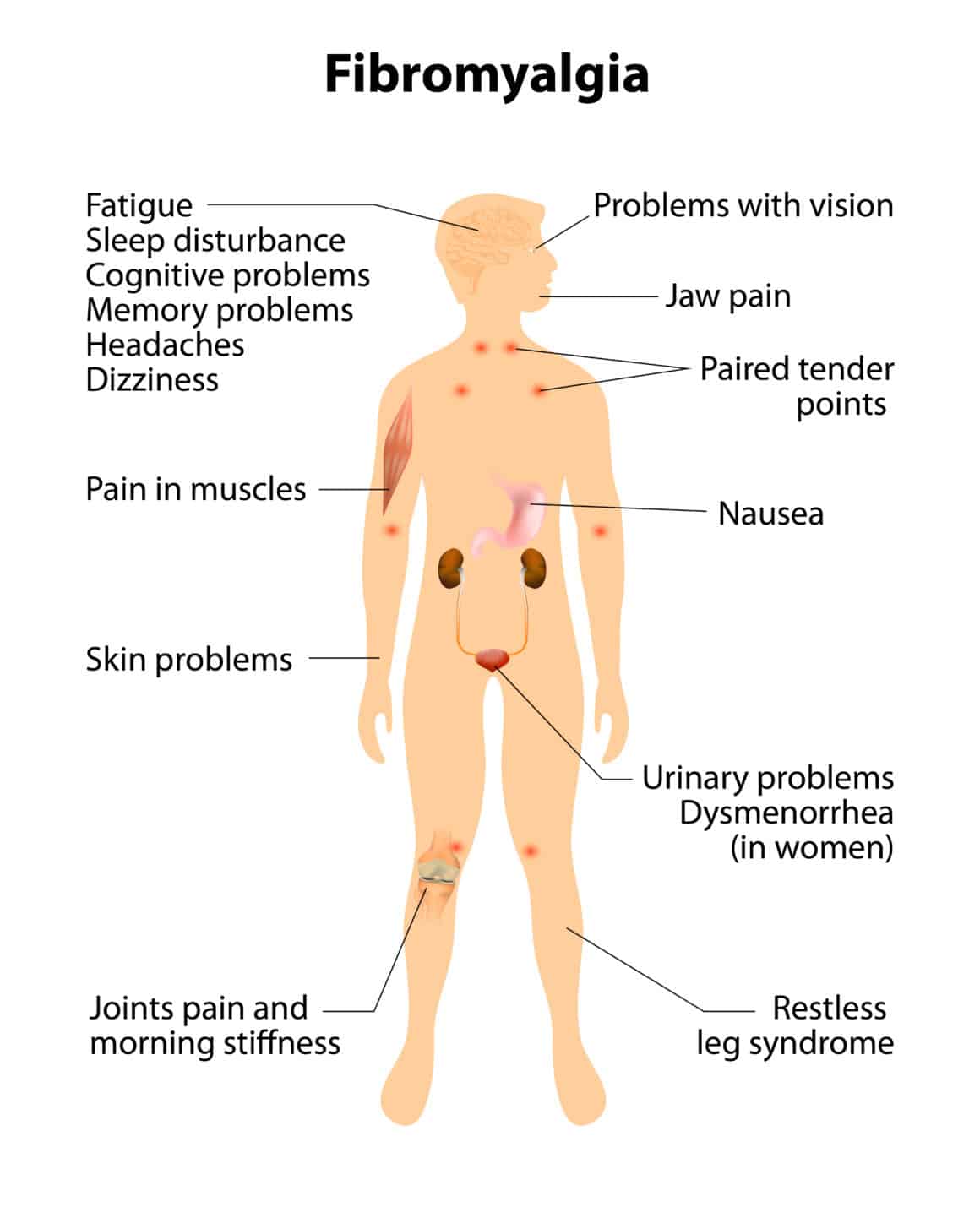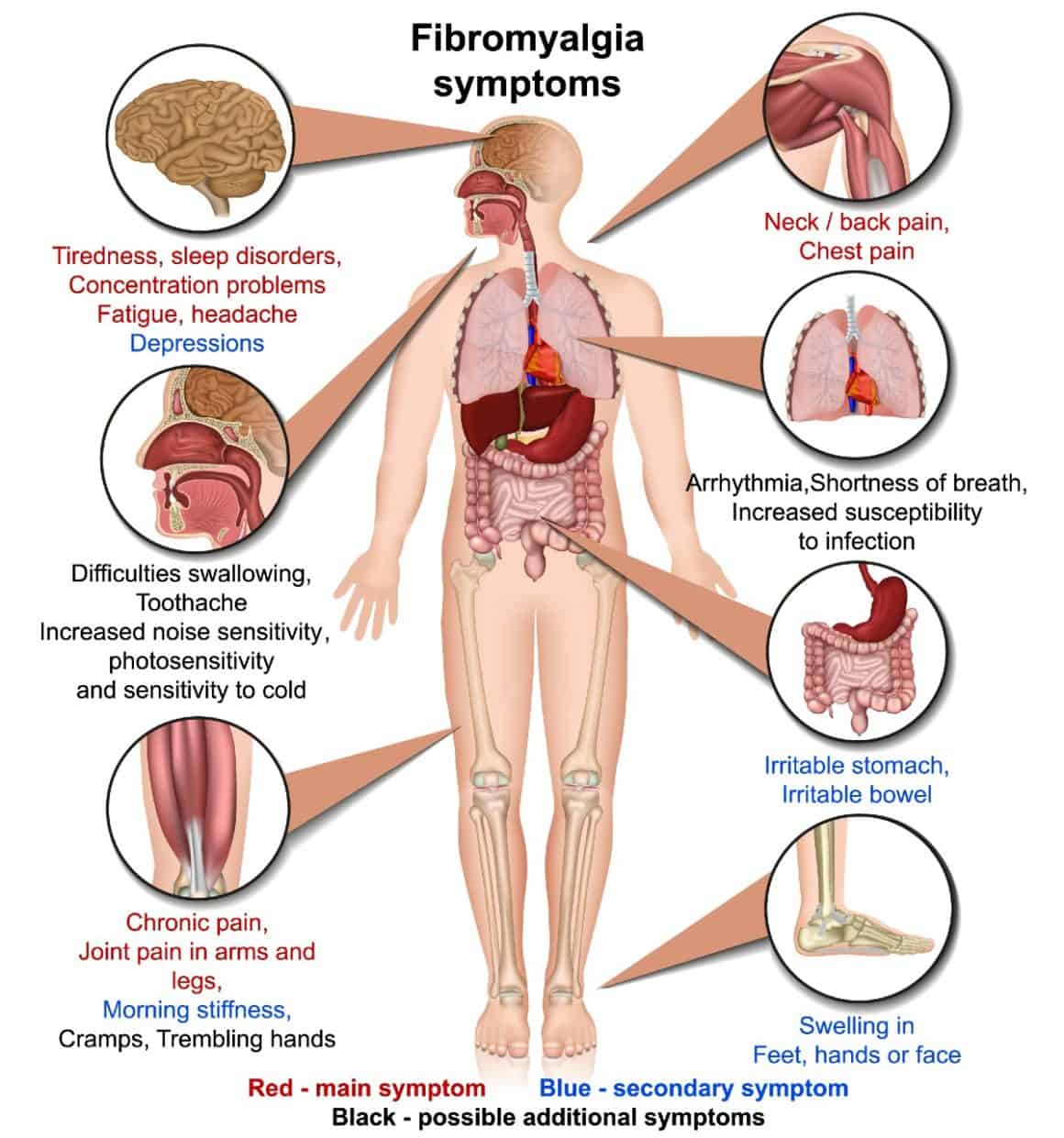Fibromyalgia affects many parts of the body and can present differently in different people, but there are a few common symptoms, according to the Centers for Disease Control and Prevention (CDC). Some symptoms are more common than others.
Symptoms
- Diffuse pain, muscle aches, and stiffness all over the body; there may also be tissue tension or pain called “trigger points” or “tender points” in certain areas
- Extreme sensitivity to pain (hyperalgesia); for instance, stubbing your toe may cause extreme and long-lasting discomfort
- Feeling pain from a stimulus that doesn’t normally cause pain (allodynia); for instance, feeling pain from the touch of your clothing against your skin
- Frequent headaches or migraines
- Persistent fatigue
- A feeling of “heaviness” in the limbs
- Tingling and numbness in the hands and feet
- Pain and dysfunction in the jaw, sometimes called temporomandibular joint syndrome (TMJ)
- Frequent digestive issues, including bloating, constipation, diarrhea, stomach pain, or irritable bowel syndrome (IBS)
- Depression, anxiety, and other mood and mental health problems
- Impaired memory, decision-making, thinking, and concentration (some people call this symptom “fibro fog“)
- Difficulty falling or staying asleep
- Dizziness
- Feeling “clumsy”
- Feeling too hot or too cold
- In cisgender women, very heavy and painful periods
- Increased sensitivity to bright lights, smells, temperatures, and certain foods

Designua/Shutterstock.com 
medicalstocks/Shutterstock.com
FAQ
What are the first signs of fibromyalgia?
The early warning signs of fibromyalgia can be different from person to person. Things like widespread pain and muscle aches, localized “trigger points,” persistent fatigue, and sensitivity are among the most common signs and symptoms of this syndrome.
What triggers fibromyalgia?
Various things can trigger fibromyalgia symptoms and cause them to flare up or get worse. These may include anything that causes physical and/or emotional stress, such as:
- viral infections,
- surgery,
- giving birth, and
- the loss of a relationship or loved one.
What are the 18 tender points of fibromyalgia?
Many people with fibromyalgia experience painful trigger points or tender points—areas of increased stiffness, muscle spasms, pain, and fascia tension (fascia is a connective tissue that encases other tissues inside the body). Experts have identified 18 common trigger points that can cause problems for people with this condition.
These penny-sized points are located in the:
- Lower neck in front
- Edge of upper breasts
- Near the elbows
- Knees
- Base of the skull on the back of the head
- Hips
- Upper outer buttocks
- Back of the neck
- Back of the shoulders
These tender points are used to help diagnose fibromyalgia. According to the American College of Rheumatology (ACR), however, they are no longer required to confirm a diagnosis.
What are the most severe symptoms of fibromyalgia?
Symptoms of fibromyalgia can be mild to severe, including severe pain and increased sensitivity that makes even light touch extremely distressing.
Fibromyalgia may also lead to complications for some people, including:
- an increased risk of hospitalizations,
- higher rates of depression,
- decreased quality of life,
- increased risk of rheumatic conditions, and
- increased risk of death from suicide and injuries (even though fibromyalgia itself is not fatal).
Disclaimer: this article does not constitute or replace medical advice. If you have an emergency or a serious medical question, please contact a medical professional or call 911 immediately. To see our full medical disclaimer, visit our Terms of Use page.







